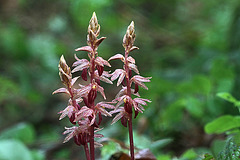RHH's photos with the keyword: Selected
Calypso bulbosa var. occidentalis
| 25 Jul 2011 |
|
While hiking at Chiwaukum Creek near Leavenworth, Washington, we found this one plant of the Western Fairy Slipper that was almost white. There is a white variety, but this is not it - just a very light-colored form, but beautiful none the less.
nativeorchidsofthepacificnorthwest.blogspot.com/2011/07/c...
Masdevallia ampullacea 'Connor'
| 27 May 2011 |
|
|
In Explore May 27, 2011, #365.
Masdevallia ampullacea is another species in the saltatrices section of the genus Masdevallia. That translates into tubular flowers with longish tails and a kind of bulging "belly" at the base of the flowers. This group includes many of my favorite Masdevallia species.
The plant is small, 6-7cm tall, and the flowers which are held on spikes near the top of the leaves are 7cm tall from the tips of the tails. The flowers have a faint sweetish scent that I cannot identify and have hair-like glands on the inside of the tube. The plant hails from Ecuador.
Note: this was awarded as Masdevallia aurea but has been identified as Masdevallia ampullacea and the award is now under that name. The two species look quite similar and could be confused, though I still have my doubts.
For more pictures go to: orchidsinbloom-ron.blogspot.com/2011/05/masdevallia-aurea... .
Neocogniauxia monophylla
| 12 Sep 2011 |
|
This small orchid species is native to Jamaica where it grows at high elevations in the Blue Mountains. It has always been considered to be related to the larger Cattleyas, but recent studies have suggested that it is more closely related to the Pleurothallids. The flowers are 3-4 cm in size on a plant that is about 15 cm tall with very thin pseudobulbs and narrow leaves. It is best grown mounted, and with cool temperatures and plenty of water.
orchidsinbloom-ron.blogspot.com/2011/09/neocogniauxia-mon...
Stelis ciliolata
| 22 Nov 2011 |
|
|
Just had to post one more picture of these unique flowers. They are small - each one is only 1.5 cm, but they have up to six flowers open at a time and bloom successively on rather long spikes. This orchid species is from Ecuador.
Published in the December, 2011, issue of Orkideer, the magazine of the Swedish Orchid Society in an article on orchid photography. The editor of the magazine, Karma Forester, has a site on Flickr, www.flickr.com/photos/myorchids/ and a blog, www.orchidkarma.com .
This was published again in on the front cover of the December 2012 issue of Orchids, the magazine of the American Orchid Society as the feature photo for an article showing some of the AOS's orchid photos of the week.
orchidsinbloom-ron.blogspot.com/2011/10/stelis-ciliolata....
Corallorhiza striata var. striata
| 05 Jun 2012 |
|
These Striped Coralroots are finished blooming now except at higher elevations, but are one of our favorite native orchids, and one we always look for when in bloom. They have the largest and most beautiful flowers of all the Coralroots in our area and are also more difficult to find than many of the others.
This photo was taken in Larrabee State Park on the coast and on a rainy day. We found a lot of Striped Coralroots there this year, perhaps due to the late, cold and wet spring. Larrabee is in the Chuckanut Mountains and is a wonderful place both for its wildflowers and for its tide pools.
The Coralroots are mycotropic plants, without leaves (which makes them hard to find when not in bloom) and without chlorophyll, deriving their nourishment from the soil through a relationship with a fungus (funny thing with which to have a relationship, but that's the way it is). Interesting plants!
More photos and text here: nativeorchidsofthepacificnorthwest.blogspot.com/2012/05/s...
Field Crescent on White Bog Orchis
| 02 Sep 2012 |
|
|
|
We were up on the Old Blewett Road in eastern Washington several times recently and both times it was warm and sunny and the butterflies were everywhere. We had gone to see the orchids and the butterflies were an unexpected bonus. We managed to catch both in this shot.
The Tall White Bog Orchis, Platanthera dilata var. dilatata is extremely fragrant and that in combination with the white flowers would suggest that butterflies such as these are the principle pollinators. In this case the butterfly's tongue can be seen reaching into the flower.
There are two other varieties of this orchid, variety leucostachys and variety albiflora, distinguished by the length of the spur. In these flowers the spur is about equal in length to the lip as can be seen in the photo. In the other varieties the spur is longer or shorter.
This was published as a two page center spread in the December 2012 issue of Orchids, the magazine of the American Orchid Society, along with a brief article on field photography. The photo was chosen from the AOS's photo of the week gallery.
ronaldhanko-orchidhunter.blogspot.com/2012/08/old-blewett...
Masdevallia ampullacea 'Connor'
| 05 Dec 2012 |
|
|
Both the distinguishing features of the group to which this species belongs can be seen in the photo. The glandular hairs with which the flower tube is lined and the "belly" at the base of the flower show that this species belongs to Masdevallia section Saltatrices. The species is from Ecuador and is fragrant.
orchidsinbloom-ron.blogspot.com/2012/11/masdevallia-aurea...
Jump to top
RSS feed- RHH's latest photos with "Selected" - Photos
- ipernity © 2007-2025
- Help & Contact
|
Club news
|
About ipernity
|
History |
ipernity Club & Prices |
Guide of good conduct
Donate | Group guidelines | Privacy policy | Terms of use | Statutes | In memoria -
Facebook
Twitter







